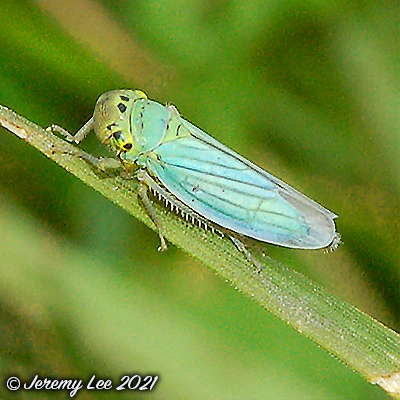
 |
|
Scientific Classifications explained » Amphibians » Ants » Aphids » Bees » Beetles » Birds » Bugs » Butterflies » Caterpillars » Damselflies » Dragonflies » Earwigs » Flies » Frog/Leafhoppers » Fungi » Galls » Grasshoppers » Harvestmen » Hoverflies » Lacewings » Ladybirds » Leaf Mines » Lichens » Mammals » Millipedes » Mosses » Moths » Sawflies » Slugs » Snails » Spiders » Trees » Wasps » Wild Flowers » Woodlice |
UK Nature > Frog/Leafhoppers > Cicadella viridis

Scientific Name: Cicadella viridis Common Name: Green Leafhopper With a length of 6-8mm, Cicadella viridis, more commonly known as a Green Leafhopper, is a largish, attractive species which is widespread and common in damp grassy and marshy areas throughout the UK, although they can be encountered in drier areas too. The bicoloured pronotum (yellow at the front and green at the rear) is distinctive. The female's forewings are bright turqoise green, but the male's can be much darker blue-purple and may even appear blackish. The front of the head is pale yellow, with two black spots near the compound eyes. Adults are active July-October. The larvae are yellowish and have two brownish stripes running from head to the end of the abdomen. Cicadella viridis may have one or more generations per year. This species overwinters in the egg stage. |
|

https://www.uknature.co.uk is a website dedicated to showing the immense diversity of UK nature and wildlife. Our vast range of habitats, from lowland arable to snow covered mountains, from storm-ravaged coastlines to peaceful inland freshwater lakes and rivers, from dry, sandy heaths to deciduous and coniferous forests, all these habitats contribute to the abundance of UK nature. We have wild birds in huge numbers either residing or visiting our shores (597 recorded species as at July 2013) and we must also not forget the humble back garden with its grass lawns, flower beds filled with nectar rich flowers, shrubs and trees, all designed to attract huge numbers of insects such as bees, moths, butterflies and hoverflies; and finally the small ponds which provide safe havens for frogs, toads, newts and even slow worms and grass snakes. www.uknature.co.uk is the showcase for my personal passion, photographing uknature in all its glory. I sincerely hope you all enjoy the fruits of my labours. This site and all images contained therein is © Jeremy Lee 2004 - 2021. All Rights Reserved. Site design by Jeremy Lee. Site development & IT Support by Stuart Lee. |